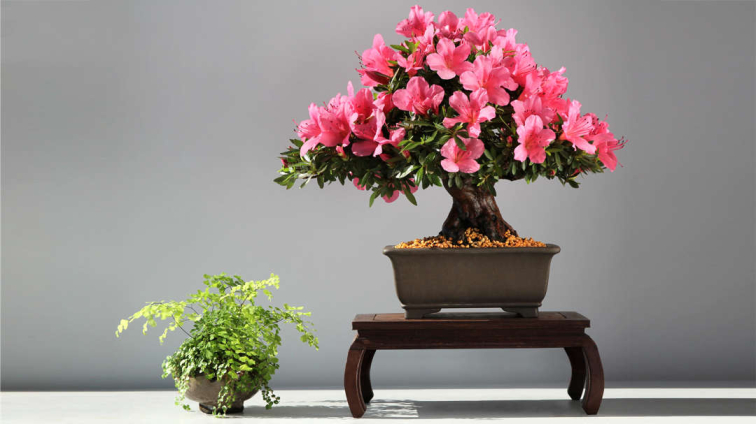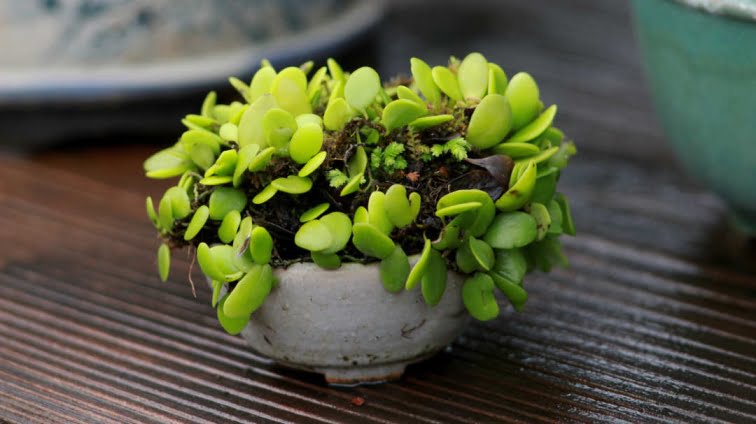
Selecting the right bonsai accent plants is crucial for displaying your bonsai and creating a captivating appearance. For those who are wondering what an accent plant is-it’s basically a low-maintenance plant that accompanies bonsai and at the same time helps to accentuate the look of the bonsai. Think of them as a supporting character in your bonsai journey. But choosing the right one for your tree can be hard and this is where this article will help. In this article, I will give you a brief guideline on how you can choose your accent plants and how to keep them alive.
Key takeaways:
- Take into account the seasonal effects on the accent plant. Observe the outlook of the tree in different seasons.
- Consider the size of the tree to make sure it does not overshine the bonsai itself.
- The container of the accent plant should complement the plant and the bonsai.
- The plant should complement the habit of the bonsai tree.
By considering the factors and following the guidelines you will acquire enough knowledge to select a suitable accent plant for your bonsai to add that extra oomph in your bonsai journey.
Table of Contents
What are accent plants?

Accent or ‘companion’ plantings as they are popularly known are cultivated to complement bonsai trees when being displayed. They are seated near the bonsai and usually reflect the tree’s personality, adding realistic detail to the exhibition.
Accent plants are extremely fast to develop and effortless to make. This will add another dimension to your hobby. Being fairly tiny, they also have the added benefit of being relatively cheap (you can even get some of them for free).
However, a good way to get fast results is to buy or get at least three small plants and plant them all in one container. This guarantees the formation of an established plant in no time.
Any plants with small leaves can be candidates for bonsai accent plants. Some species like diminutive irises and small ferns mirror the characteristics of a bonsai and help to create the illusion of scale.
| Aspect | Description |
| Purpose | Enhance the aesthetic of bonsai. |
| Characteristics | Small, unique, and complementary to the bonsai tree. |
| Placement | Positioned in the same container or near the bonsai. |
| Scale and balance | Adds a sense of realism to the display. |
| Care | Minimal care. |
| Traditional art | An integral part of bonsai art. |
| Cultural significance | In some cultures, specific accent plants hold cultural significance. |
Factors to consider when selecting bonsai accent plants:
When choosing a bonsai accent plant for your bonsai, here are some of the factors you should consider and follow.
Season:
Seasonal effects in bonsai accent plants are important. For example, flowering accent plants possess different characteristics in summer, winter, fall, or spring. This characteristic can be used to create seasonal characters in bonsai exhibitions. Especially with evergreen trees, accent plants show their seasonality.
The color of leaf, flowers, and fruits are important so it’s ideal when the accent plant matches the current season.
Typical characteristics of plants in different seasons:
| Season | Characteristics |
| Summer | Lush foliage, bright blossoms |
| Spring | New growth, vibrant flowers |
| Fall | Colorful foliage, changing leaves |
| Winter | Evergreen foliage, cold-hardy |
Size and scale:
The smaller the size of the bonsai, the accent plant should be even smaller. The bonsai accent plant should never compete with the bonsai in terms of size. It should stay harmoniously compacted near the bonsai and should never compete and overshadow.
Tips
- The height of the plant shouldn’t surpass the height of the bonsai.
- Skinny or too-small plants next to a bushy bonsai tree will attract attention, so it should not be too short or long.
Container:
The POT should complement the bonsai in its overall look.
Accent plantings can be established in tiny glazed or unglazed containers. Slate and tiles are other popular choices for planting and In that case, moss should be cultivated near the soil to form a mature-looking plant.
Another significant complementary factor is that the containers should be of various shapes – if the bonsai is in a round container, the accent plant’s container should be anything but round.
The material of the pot should be different as well. If a ceramic container has been employed for bonsai, one would place the accent plant on a wooden base, not a ceramic tile.
Additionally, the direction of the tree should be considered when settling on placement in the display, the tree and plant should ‘face’ each other.
Helpful tips:
- The ceramic and wooden containers go well with each other.
- The size of the pot should be smaller than the bonsai pot.
- Mismatched containers of bonsai and accent plants create a good display.
Habitat:
The bonsai accent plant selection should be similar in terms of the habitat in which the tree originated. This way it will grow and create a more naturalistic essence of its position in nature.
For example, grass that is from a mountain climate would match well with a bonsai tree from the exact climate.
A Scots pine might operate nicely being paired with an accent plant like wild thyme. It won’t go well with a tropical orchid, or succulents that are from deserts.
Also, bonsai trees that grow in rock resemble a sign of struggle to survive and that tree should be paired with a not-so-luxuriantly growing accent plant.
Combination accent plants range from the simple, such as a cluster of dwarf grass encircled by moss, to more complicated plantings of several species. Grouping small plants of varying sizes can result in a very beautiful set to use as an accent.
But when incorporating several bonsai accent plants to construct one accent plant, make sure they are from similar origins so it will be easier to resemble nature.
Tips:
- Bonsai trees with flowers or fruits should be contrasted by non-flowering bonsai accent plants, and vice-versa.
- Avoid tropical plants with mountain bonsai species.
- Taller types, like the literati, can be paired with a tall grass variety.
Where to purchase bonsai accent plant:
When it comes to buying bonsai accent plants, there are different options you can check out and select a perfect addition to your collection.
Online purchasing:
Many bonsai sellers offer a vast selection of accent plants online. Websites devoted to bonsai cultivation offer accent plants as well. Online stores cater to different skill levels and preferences. You can even find bonsai accent plant sellers on online marketplaces like Amazon.
Offline purchasing:
If you are looking for a hands-on approach, your local nursery will help you out. Here you can inspect closely before picking a piece.
| Online options | Offline options |
| Amazon | Local Nurseries |
| Etsy | Garden Centers |
| TN Nursery | Bonsai Clubs |
Tips:
When purchasing bonsai accent plants, be sure to check the hardiness zone for the species. If you are keeping them inside, then it’s fine, or else be certain that the plants you are getting are hardy for your climate zone.
Zero-cost accent plants:
If the bonsai you are growing resembles your region’s atmosphere, you can use plants growing in your backyard abundantly as your accent plant. Wildflowers and other native plants that are visually appealing can be incorporated effortlessly for free.
Bonsai and their suitable accent plants:
| Bonsai | Accent plants | Buy bonsai | Buy accent plant |
| Juniper | Succulents | Juniper bonsai | Succulents |
| Pine | Stonecrop | Pine bonsai | Gold Moss Stonecrop |
| Spruce | Succulents | Spruce bonsai | Succulents |
| Cedar | Sedum spectabilis | Cedar Bonsai | Sedum spectabilis |
| Maple | Purple Shamrock | Maple Bonsai | Purple shamrock |
| Elm | Dwarf Columbine | Elm bonsai | Dwarf Columbine |
| Hornbeam | Thyme | Hornbeam seedling | Thyme |
| Beech | Jade plant | Beech seeds | Jade plant |
Some accent plants and their characteristics:
| Accent Plant | Characteristics |
| Ferns | A large-sized, woodland tree-shaped bonsai or any kind of big woodland planting would be a suitable spot for some of the smallest fern species. |
| Lichen | They are extremely picky as to what they will grow upon and where. Some attach to bark in moist dark areas, others only on completely exposed and well-drained stones. |
| Mosses | Pick the drought-resistant, slow, and short-growing varieties. |
| Succulents | All of these are appreciated in well-drained conditions. They are the least picky accent plant. |
| Herbs | Dwarf varieties of herbs form a carpet of small deep green leaves with small purple blossoms in spring. |
Caring for bonsai accent plants:
Proper care of bonsai accent plants is crucial to ensure that they are healthy because having yellow or deformed trees will attract attention. Usually, they follow similar care tips as the bonsai, still here are some tips for caring for accent plants.
Watering:
Depending on the kind of plant, it may demand more or less frequent watering sessions.
As a general rule of thumb, water when the upper part of the soil feels dry.
Fertilizing:
Accent plants don’t require fertilizer often and as they are living in a tiny pot, they tend to get over-fertilized. But springtime slow-release fertilizer will give a boost to their growth.
Pruning:
Dead leaves or yellow leaves should be trimmed as soon as possible, not only they will divert attention but also can kill the plant by overcrowding. Prune accent plants just like any other houseplants.
Pest control:
Accent plants don’t usually get attacked by pests but if you notice any pests use neem oil or pick the insect out manually by hand.
Conclusion:
Bonsai accent plants are usually overlooked for being small and less important in the gardening world, but once you implement them you will realize what was missing from your bonsai exhibition. Of course, choosing one for yourself is a personal preference but I hope the article’s guideline will help you to choose one that suits your bonsai. Just keep in mind the water requirements of the plants, because the small pots they are living in don’t hold much soil.
FAQs
What are the other companions for the bonsai tree display?
Miniature bridges, birdhouses, tree logs, pagodas, lanterns, small statues, benches, and anything that will go well with the aesthetic of the bonsai without overpopulating or overshadowing it can be used as accents.
What is kusamono?
Kusamono is wildflowers and grass potted in unique pots and trays. Nowadays kusamono is popularly used as an accent plant near bonsai. It can be tall or short, a mixture of different plants. The gives the impression of place and season.
What is shitkusa?
Closely related to kusamono, shitakusa is the proper term for displaying bonsai or similar exhibits. Outside of Japan, you will typically hear the word companion or accent plant, however, these plants may be most fitting as shitakusa.
What is kokedama?
Kokedama or moss ball, is a ball of soil, encircled with moss, on which a decorative plant grows. The concept originated in Japan and has been a part of the practice of bonsai, but it has evolved into its own art form.
